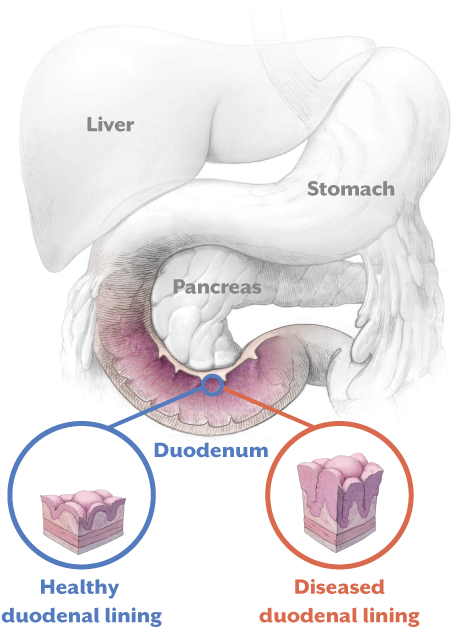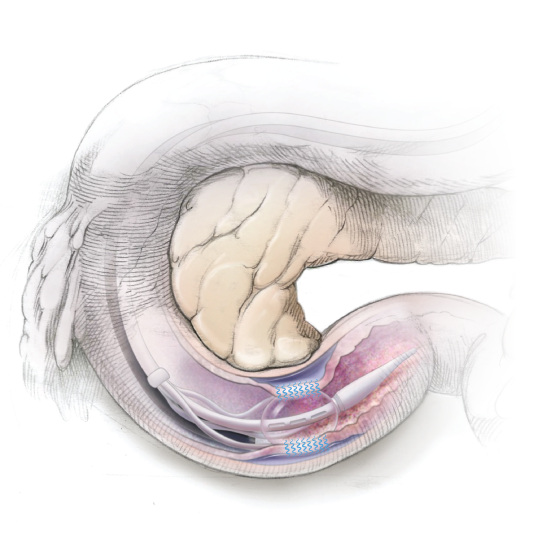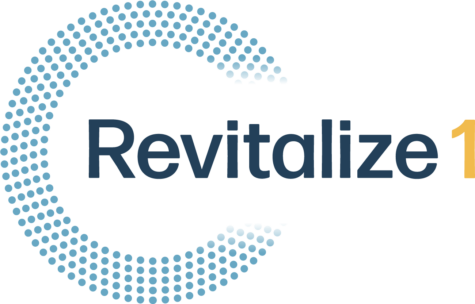Revitalize 1 Study

Researchers believe that the first section of your small intestine (the duodenum), located just after your stomach, has an important role in the development of type 2 diabetes. The duodenum is sensitive to the foods you eat and helps you to maintain a healthy metabolism and blood glucose levels. However, in people with type 2 diabetes, the duodenum lining may be thickened or diseased in a way that may make it hard to maintain a healthy metabolism and blood glucose levels.1,2,3,4

The Revitalize 1 Study is evaluating an investigational clinical procedure called duodenal mucosal resurfacing (DMR). The DMR procedure called Revita® targets the lining of the duodenum and uses heat to remove the thickened or diseased lining so your body can regrow a new healthy lining capable of potentially helping to control blood glucose, improve insulin resistance, and improve control of diabetes without needing to take more medicines or insulin.
In previous studies that evaluated DMR for the treatment of diabetes, improvements in blood glucose control and weight were seen after a single outpatient procedure.5,6,7
The revitalize 1 study consists of three periods:
Screening Period
(up to 6 weeks)
This will include 3 study visits at the study center or your home. It is during this period that it is determined if the study is suitable for you. The study doctor may adjust your medications during this period.
Day of DMR Procedure
(1 day)
You will visit the study center to have the procedure, which is expected to last approximately one hour, and go home the same day. The study team will review with you a modified diet to be followed for 14 days.
Follow-Up Period
(about 1 year)
This will consist of 6 study visits at the study center and 5 phone calls. It is during this period that your progress will be monitored. The study doctor will further adjust your medications during this period.
Revitalize 1 study overview
Sources:
- Dyer at al. Am J Physiol Gastrointest Liver Physiol. 2002;282;G241-G248
- Fiorentino et al. J Clin Endocrinol Metab. 2017;102(11):3979-3989
- Verdam et al. J Clin Endocrinol Metab. 2011;96(2):E379-E383
- Aliluev et al. Nature Metabol. 2021;3:1202-1216
- van Baar et al. Gut. 2020; 69(2):295-303
- van Baar et al. Diabetes Res Clin Pract. 2022;12:109194
- Mingrone et al. Gut. 2022; 71(2):254-264
Frequently asked questions

About this Research Study:
You, or a loved one, may be able to participate if you/they:
- are 21–70 years of age
- have been diagnosed with type 2 diabetes
- have an HbA1c between 7.5-10%
- have a body mass index (BMI) between 24-40
- are currently taking insulin and other medications
If you pre-qualify, your next steps are the screening and preparation period. During this time it will be determined if the study is right for you.
Participants will receive either the investigational treatment (DMR) or a sham (placebo) procedure. A sham procedure provides no active treatment as there is no removal of the excess layer of the duodenum. If eligible, depending on the procedure you receive, you will be enrolled in the Revitalize 1 Study for about 1 or 2 years. You will be offered the opportunity to receive Revita later in the study if you start off in the group receiving the sham procedure.
No. All eligible participants can receive the procedure and medical care related to the study at no cost and compensation will be provided.
Stay informed of future studies you may qualify for by clicking here.
